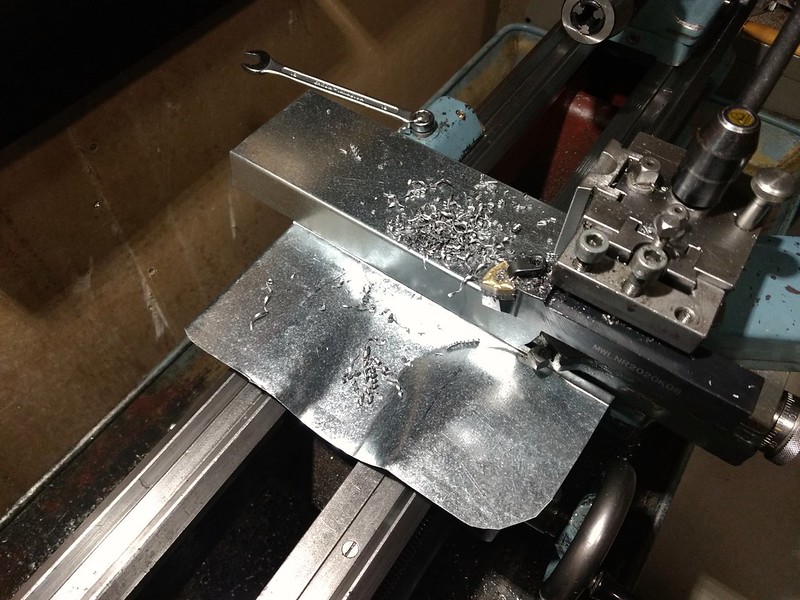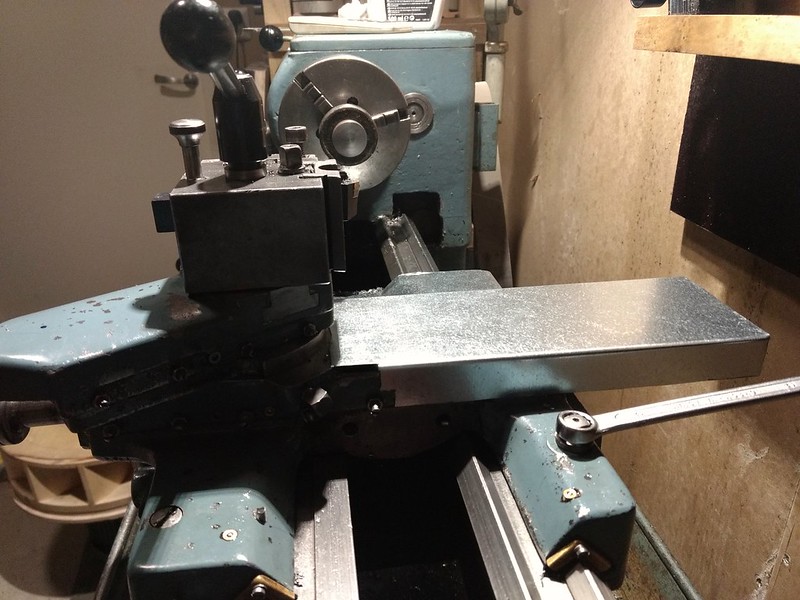|
Rapulum_Dei posted:Iíve bought linear rails like that from aliexpress, a 500mm one was like $15. yeah i'm overcomplicating this, i looked at some spec sheets and i was pricing out parts twice as big as i need for the project. if there's any issue aliexpress rails will create for me it'll probably be the preload, i need zero preload or ideally some clearance so the slides move freely but sellers only seem to offer light and medium preloads, which makes me suspect whoever makes these knockoff carriages only offers those two oversizes of ball bearing then again these things offer a magnitude higher precision than i need for this project, so if things were unacceptably stiff i could probably open the rail channels up the needed handful of ten-thous with some super fine sandpaper wrapped around a rod. who needs gothic arches anyways Ambrose Burnside fucked around with this message at 03:04 on Sep 18, 2018 |
|
|
|

|
| # ? May 11, 2024 21:13 |
|
I saw two big splits in grinders at IMTS. Mainly in how the systems moved. About half the machines had flat-V ways and the other half used crossed X roller bearing linear slides. In years past the flat-V way was always king, not entirely sure why the high end stuff (some of it) is going to linear slides. Are the linear slides just getting that good? I'd much rather just buy a new linear slide than have to scrape in a boxed V. The skill required to do that is orders of magnitude higher.
|
|
|
|
|
Yooper posted:I saw two big splits in grinders at IMTS. Mainly in how the systems moved. About half the machines had flat-V ways and the other half used crossed X roller bearing linear slides. In years past the flat-V way was always king, not entirely sure why the high end stuff (some of it) is going to linear slides. Are the linear slides just getting that good? I'd much rather just buy a new linear slide than have to scrape in a boxed V. The skill required to do that is orders of magnitude higher. i mean, i don't know poo poo about ~industry trends~, but in researching linear shafts/rails et al this past week ive noticed that the age of the thread on practicalmachinist or w/e has a definite, heh, bearing on people's opinion of them. that's prolly down to old fogey manual machinists aging out and young hobbyists building their own machines coming in as much as anything else, but the fogeys aging out means people who can handscrape to a professional standard have also aged out. our shop lost our tech of 35 years not too long ago and we're not sure what we're gonna do to maintain a bunch of the oldass manual machines when something happens, we're just gonna chuck stuff when we start getting specialist repair invoices that were previously done in-house or through said wizened tech's connections to practitioners of the old ways. if just swapping out a rail or carriage was an option we'd probably jump on it. i'm not super surprised people are starting to get out of their comfort zones and acknowledge the writing on the wall for something like this where the shaky economics and increasingly-difficult long-term viability start offsetting the prestige scraped ways carry Ambrose Burnside fucked around with this message at 03:19 on Sep 18, 2018 |
|
|
|
another factor i saw someone mention that sounds compelling is that machining itself has changed over time; business customers in North America are far less likely to have to regularly do monster megahogging out type work nowadays than they were in 1960 or whatever, so a box way's clearest advantages (rigidity, higher practical loads n associated traits) matter less now. on the flipside, higher rapids speed is an easy way to improve productivity, and that's where linear guides excel idk how much that carries over from conventional machining to fancypants high-end grinding but 
|
|
|
|
Eeeeh, I donít know how to judge it comparatively. They work, the dimensions are in spec, the friction is low and consistent across their whole length.  You could always use cheapo ones to prove the design and get hywin or misumi if necessary.
|
|
|
|
Does anyone err know anything about buying second hand robots? A couple here are on auction and I am tempted to bid: http://www.graysonline.com/lot/0048-7020832/mechanical-workshops/group-of-4-x-welding-robots 4 ABB robots... Chances they will work ? Or be mechanically sound enough to retrofit? (I am aware this is the blacksmithing thread but I thought a couple of you engineers would be able to advise me)
|
|
|
|
Mudfly posted:Does anyone err know anything about buying second hand robots? A couple here are on auction and I am tempted to bid: I can't speak from experience of buying second hand welding robots, but I have bought enough industrial crap second hand. Industrial processes that require machinery to do repetitive motions are a crapshoot that usually end in tears if you don't know how to tear down, and rebuild the machine from rivet up. These are things that repeat the same motion over and over until every nickle is squeezed out of them and they are dumped usually for scrap. If you're lucky, it's because they went out of business and you are getting a machine with only millions of ops on them instead of billions. I don't know how much those things cost new, but I bet it's more than 2 grand and if you get enough parts to make 1 work out of 4 I bet you'd be doing great. These kind of deals I usually only make a pass on pennies on the dollars or free and dumped in my lap.
|
|
|
Mudfly posted:Does anyone err know anything about buying second hand robots? A couple here are on auction and I am tempted to bid: The price is not bad. They are also modern enough (2007) to still get parts. There was an hour meter on something, but that doesn't mean poo poo unless you get a look at the "real" hourmeter in the control. They look decent as far as welding robots go. They will require 3 phase power too, and no way around it. Give them all chainsaws and see which is toughest.
|
|
|
|
|
I autopsied one BMW retired and gave to my community collge, they never set it up because the safety envelope would've taken up the entire lab. I also work for a precision components supplier to the auto industry and while we don't have anything that big, robot arms tend to be some of the most fussed over, carefully maintained equipment in the plant because they're so expensive and almost always a production bottleneck. While it's true that they'd have been run to the point of irreparable uselessness for the previous owner, that means it's worn enough not to be able to hold their tolerances, not that the machine is dead. The welding shop probably has a fair bit more play but we would be looking to replace something that positioned parts for assembly once it couldn't repeat to 100µm. Also at 10 years old they've already deprecated off the books entirely so there's no reason they wouldn't just give them away from an accounting standpoint.
|
|
|
|
I'm keeping robots older than that running at work, the big ticket items are the gearboxes which aren't serviceable in ours. "Failure" mode is the boxes binding at speed and overloading the motors. We could run them for millions more cycles at lower speeds of that were acceptable. Also ours have the brake resistors degrade and fault out after about 4 years of use. If speed and precision aren't vital and you can program it somehow go hog wild.
|
|
|
|
Pagan posted:I wrote an article on managing coal fires, for my local blacksmithing group. I got a ton of positive feedback, so I figure it's worth sharing. That was a really good read, thanks for typing it up and sharing. Mind if I stick it in the op?
|
|
|
|
e
Ambrose Burnside fucked around with this message at 21:30 on Sep 19, 2018 |
|
|
|
I bought 20 DGMT Korloy inserts on AliExpress for $20 shipped. They are legit Korloy too. I love AliExpress.
|
|
|
Pagan posted:I wrote an article on managing coal fires, for my local blacksmithing group. I got a ton of positive feedback, so I figure it's worth sharing. Seconding the good read. I actually learned something about the slag buildup that I also see in my coal heating stove. One time the slag got so bad after three days of continuous operation there was a dome of it over about 5lbs of unburnt coal, with the current fire running just fine on top of the dome. When I finally let it cool down I had to use a fire poker like a chisel to break through it because as it cooled it had clumped up even further to form a solid barrier. Reminded me a lot of a coconut shell.
|
|
|
|
|
Interesting, thanks for the replies. My thoughts were the robots would be really great if I could pick them up somewhat cheaply at around 2k - maybe even retrofit them with chinese servos if the electronics were fried. In the end the bidding went nuts and they went for $20,000. Still, it will be interesting in the future when these robots are as ubiquitous as older cars are to get a hold of and 'do up'. I was thinking of creating an extremely dangerous sculpting robot by giving it a circular saw and a log.
|
|
|
|
Slung Blade posted:That was a really good read, thanks for typing it up and sharing. Please do! I'm glad everyone likes it. Almost every blacksmiths shop I've been to has a "biggest clinker" displayed somewhere. It stays in a special spot until one day someone finds a bigger piece, and so on.
|
|
|
|
Any UK goons want to go see a cool metal thing in London? https://www.dezeen.com/2018/09/18/japan-house-metalwork-masters-london-design-festival/ London Design Festival exhibition shines a light on Japanese metalwork masters I'm in California so I won't be checking it out, but I figured it's worth a heads-up.
|
|
|
|
Prototyping a chip / swarf / coolant fluid protection. Not sure if sheet metal is the way to go or if I should just make a neoprene cover like I have seen some do.
|
|
|
|
if you keep your lathe well oiled, I'm not sure you could really hurt those ways with l steel, aluminum, copper, brass chips/swarth.
|
|
|
|
Can anyone recommend a good intro to setting up and programming industrial servos? I have bought 3 Chinese ones and the manual is pretty terrible, but I'm sure it's ok for someone who's already programmed a yaskawa, fanuc, etc. Its just the literature from those manufacturers is pretty vast and intimidating, I'm not sure where to start.
|
|
|
|
what do you have?
|
|
|
|
rump buttman posted:if you keep your lathe well oiled, I'm not sure you could really hurt those ways with l steel, aluminum, copper, brass chips/swarth. yeah i wouldn't put too much work into totally shielding the ways from just chips, it can't hurt but I also question the usefulness of that if the way wipers are in good shape and not cracked or full of holes or whatever. The swarf is almost invariably softer than the ways themselves, they're not likely to be hurt much by typical swarf, even if a little gets past the wipers. If you're doing anything at all that involves stone abrasives or drops grit, on the other hand, protect the poo poo out of the ways and be as meticulous with cleanup as you can immediately after the operation in question is done and you're going back to making chips. You'd want a much more ambitious cover for that, though. Ambrose Burnside fucked around with this message at 05:18 on Sep 23, 2018 |
|
|
Mudfly posted:Can anyone recommend a good intro to setting up and programming industrial servos? I have bought 3 Chinese ones and the manual is pretty terrible, but I'm sure it's ok for someone who's already programmed a yaskawa, fanuc, etc. Its just the literature from those manufacturers is pretty vast and intimidating, I'm not sure where to start. My last foray into Chinese servos involved Delta servos. They had pretty decent documentation. They are re-branded in the US as Automation Direct SureServos. The encoders are only 2000 PPR compared to the Fanuc's and AB's with 18 bit resolution (~200,000 ppr). Automation Direct has some decent documentation. I purchased a knock-off VFD and it was an exact clone of the knock-off automation direct so you might get lucky and actually have Delta/AD guts. Post some links to whatcha got. See what we ca do.
|
|
|
|
|
I continued on my project, I dunno if you guys think it's worthwhile but I certainly think it is. Did some turning and boring with these in place and they reduced the cleanup by a lot, 99% of the crud landed on the sheet metal parts and I could just lift them off the lathe and sweep the swarf and chips right into the bin. I think it's great. The backside of the cross slide also exposed the ways a lot of the time and it would get very cruddy, so the cover extends over that. It can still be made shorter.  Since you reminded me of wipers I made new way wipers from an old leather belt, worked out quite well actually, though not visible in photos. But I think they work better than the old felt ones. EDIT: Ideally I'd have a cover that covered the whole of the cross slide on both sides of the compound, but the back of the compound mates with the surface of the cross slide unlike more modern lathes where only the swivel-portion connects. I suppose some kind of 1mm precision washer of the right size on the bottom of the compound could work to get clearance, the way the compound is secured to the cross slide should allow that deviation. Though that would reduce the contact surface to the cross slide, but I am not sure that is actually doing much of anything. EDIT 2: That kind of cover though would remove the possibility of making it easily removable which is a much more handy feature, so I believe I will leave it be. His Divine Shadow fucked around with this message at 06:33 on Sep 24, 2018 |
|
|
|
If it helps in clean up I'd say it's worthwhile.
|
|
|
|
cakesmith handyman posted:If it helps in clean up I'd say it's worthwhile. This. Plus any work wipers don't have to do should make them last longer.
|
|
|
|
I made a knife this weekend, my very first one, it has its flaws but hey I did it and learned some things to take to my next project. the billet is Damascus but the etch is not very contrasting so you cant tell to much. nickle steel and 1084.     
|
|
|
|
Just got tasked with bringing my shop's incomplete CNC plasma cutter to life. It was bought a few years back but was promptly abandoned once the software/controller side of things stopped being plug-and-play because it turned out that nobody actually needed a plasma cutter. Now we're realizing it'd be great to not have to fire up the waterjet any time we want to cut even thin steel sheet, so I get to wrestle with the dusty plasma cutter (only use so far: coatrack) and hopefully learn some stuff.
|
|
|
|
If you do, let me know what kind of tolerances you're capable of. We have enough stuff sitting around the school to put together a CNC plasma cutter with a minimum of cost but I only want to do it if a homemade (well, semi-pro, we're well-equipped) version can do reasonable work.
|
|
|
|
Yeah, for sure. Ours is an off-the-shelf commercial machine (not sure of the make/model, i'll check tomorrow) intended to be largely turnkey but it didn't shake out that way for some reason. Our waterjet is old and holds around +/-.010; I know we almost certainly won't get close to that with the plasma cutter, judging by how budgeting for Optics Purchases goes, but we'll shoot for it so it can replace the waterjet as often as is practical.
|
|
|
|
Disgruntled Bovine posted:We have a job at the moment which requires drilling a pattern of 105x .007 +/- .0002" holes in Monel. Hey guys sorry for not responding earlier, I kind of forgot to check back on this topic after I posted that. They're through holes, and the required stick-out is only .080", but even then it's a lot for such a tiny drill. We did finish the job and the parts came out good. According to our lead machinist the .010" slots next to those holes were much more troublesome as you can imagine deflection is a big issue with an endmill that small. We have no idea what the parts are for, but it's aerospace and probably military.
|
|
|
|
.08 deep is still over 10x diameter. That's deep for it's size. I've got a new appreciation for that recently. I'm doing a project at work requiring 25x diameter drills. Experimenting with gun drilling for the first time is terrifying. Broke my 4mm drill today. Per the manufacturer I'm drilling a pilot hole 2x diameter, inserting the long drill at low rpm (500) .05" above where the pilot stopped, raising the rpm and going for it. Dwell and back to 500 rpm before I retract. I'm not sure why my drill broke, it made it through 40 holes before it did and the last time I checked it I hadn't even worn the coating off. Any advice? Deeper pilot hole?
|
|
|
|
How deep was it when it broke? Do you have through tool coolant? What do the chips look like? Might be a fluke with that individual drill but if you keep getting that poor a tool life I'd ditch the instructions and try pecking. E: what are material, tool material, and tool geometry? shame on an IGA fucked around with this message at 00:26 on Sep 27, 2018 |
|
|
|
Not at work so off the top of my head: 4140 annealed Coolant through is yes for the machine and drill Drill is carbide, coated for steel (I forget which) and 140 degree tip Roughly 225 sfm and .004" per rev makes for 5500 rpm @ 20ipm No pecking atm Chips look solid, small, no tail, and shiny on the business end As for when it broke I was setting up another machine so I missed it. Similar settings on a 5xd drill are still going strong 5mm and 6mm drill still ok and show no wear
|
|
|
Disgruntled Bovine posted:Hey guys sorry for not responding earlier, I kind of forgot to check back on this topic after I posted that. Well the one thing I know that monel gets used for heavily is systems that touch and flow seawater. Might have been for a seawater/purewater heat exchanger
|
|
|
|
|
what tools would I need to work with 16 gauge steel? I'm looking to make a pair of simple steel mitten gauntlets, connected to a leather and cloth backing in the style of Japanese kote.
|
|
|
|
ballpeen hammer, cold chisel, box of aluminum rivets
|
|
|
|
also assuming you'll be dishing/sinking the sheet, for which you'll need a sinking block. a wooden stump with a couple rounded depressions of different radii worked into it is the usual solution, i made mine by roughing in the outline of the depressions with scoop chisels and then hammering a scrap piece of red-hot steel sheet into the started dishing rounds repeatedly with a well-radiused hammer, it'll smooth any hard chisel marks out and the carbonizing of the surface beneath the crumbly char hardens the wood and extends the lifetime of that particular dishing feature you can also dish in 'conforming female tooling', i.e. rubber blocks, thick leather pads, bags full of sand or shot, etc. but i would stay away from this because with a universal lower tool the upper tool- the hammer- sets the bend radius, and you are hammer-poor. its much easier to carve a bunch of dimples in a stump to suit the end result at your experience level. also you can occasionally hot-form steel sheet in wood blocks to save a ton of time and effort in the early parts of the process, which you cant do with most other conforming options also you will absolutely need an anvil of some sort big enough for the pieces youre working, even if you're not doing any real forging you'll still need a way to put a flat plane on stuff. doesnt have to be 200 pounds of steel, for simple sheet metal planishing and basic work over the edge you can probably get away with a section of ~3/4"+ thick steel rectangle barstock or sth similar you can salvage also a ballpeen hammer is a must but you can't do all the work with the peen, it's way too small a radius for anything except smaller bends close to the diameter of the peen ball. a ballpeen on flatter work just puts a lot of deep dimples in which are impossible to work out and are a trademark signifier of someone being inexperienced/not having the appropriate tooling. imo buy a second ballpeen and grind the poo poo out of both faces to get much softer versions of both the ballpeen and the flat hammer face, doubling your forming options is incredibly helpful for all the shapes in between "flat" and "a compound curve with a radius of like half an inch" Ambrose Burnside fucked around with this message at 19:21 on Sep 27, 2018 |
|
|
Yooper posted:I'd try hammering the non-edge part and see how it behaves. Not sure on using the flat part of the hammer, I'd start with light hits with the peening side. I'd strike it on the under side and try to lengthen the bottom arc with some taps. Don't think of it as hitting the arch to bend it down, but hit it under the arch to expand the metal and draw it down. wanted to say this worked perfectly and it only took a few taps to set it straight
|
|
|
|
|

|
| # ? May 11, 2024 21:13 |
|
Apologies for the dumb question, would this be the thread to ask about getting into knifemaking or is there a dedicated thread for that?
|
|
|



































